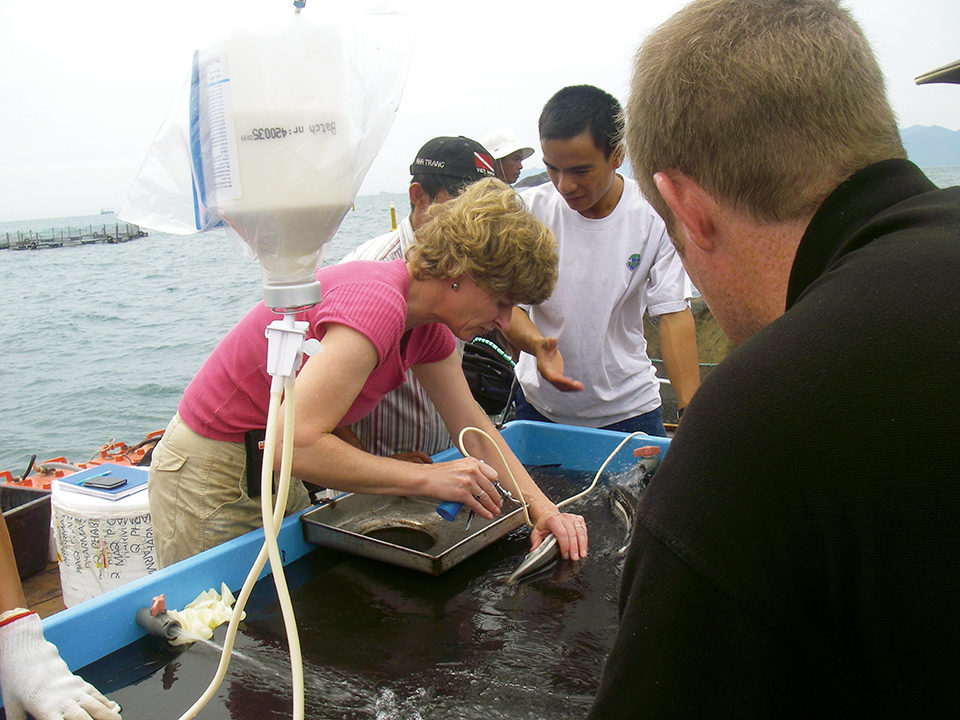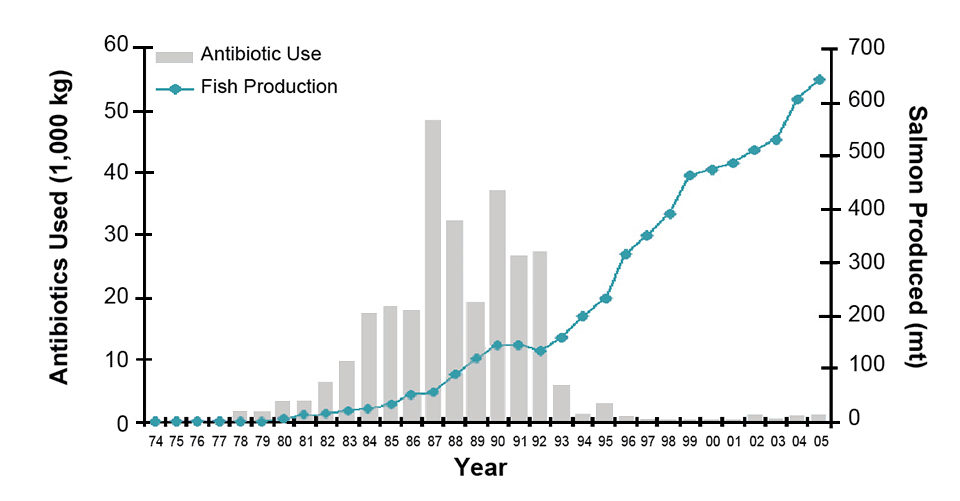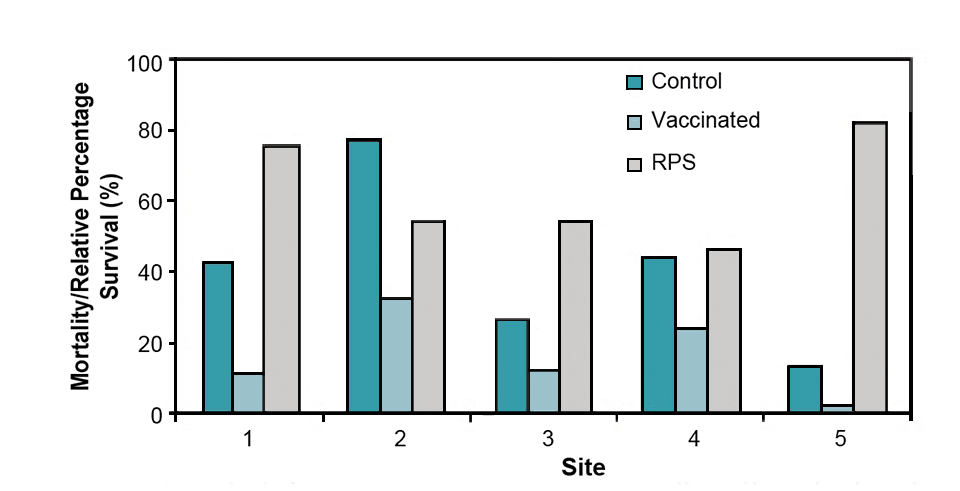Moving from treatment to prevention has greatly improved predictability

The aquaculture industry is diversifying into new fish species, particularly marine fish. In Norway, for example, four fish species (wolffish, halibut, turbot and cod) are in line for sustainable farming, and Asia has almost 100 fish species under development. Good fish health management will be key to their aquaculture success.
Although the various fish species are susceptible to different diseases and exhibit different immunological responses, understanding of the dynamics of the primary pathogens that cause the diseases, as well as the ontogenesis of the fish immune systems will contribute to effective disease management.
Vaccinations are playing a growing role in health management at farms around the world. The introduction of efficacious multivalent vaccines in Norway, for example, has almost eliminated the use of antibacterials by salmonid fish farmers and contributed positively to growth, predictability and sustainability in the industry.
Salmon vaccination
Commercial fish vaccines in salmonids are today considered reasonable insurance to avoid the diseases most prevalent within this aquaculture segment. Moving from treatment to prevention has greatly improved predictability in salmonid farming worldwide. One significant indicator of this is the dramatic reduction in the use of antibiotics as seen, for example, in the history of Norwegian aquaculture (Fig. 1).

Effective vaccines were probably the most important factor in creating the possibility for Norwegian aquaculture to grow from 65,000 metric tons (MT) in 1987 to over 700,000 MT of salmon and trout in 2007. Antibiotic use in salmonids for the same period came down from 48,500 to 649 kg, with the latter amount spread among salmon, trout and cod.
Trivalent vaccines against coldwater vibriosis and classical vibriosis proved their efficacy in 1988-89 and resulted in further growth of the industry. In 1990, the consumption of antibiotics increased due to furunculosis, as water-based furunculosis vaccines proved to be inefficient.
The first monovalent oil-based furunculosis vaccine was introduced in 1991, and in 1992, a range of oil-based products was available to the Norwegian industry. These vaccines added high protection against furunculosis and the vibrio infections, and the number of antibiotic treatments fell dramatically.
Vaccine types
Since the 1987 introduction of sal-mon vaccines in Norway, different types of vaccines have been tested and used. These include water-based immersion vaccines, water-based injection vaccines and, finally, oil-based injection vaccines that now dominate the industry.
In 1997, the first six-component vaccine for fish was launched, including an infectious pancreatic necrosis virus component as well as a Moritella viscosa component against winter ulcers in addition to the three antigens mentioned above.
Fish vaccines are today generally available in Europe, North America, Chile and Japan. It is food for thought that Asia, where the bulk of aquaculture takes place, does not yet widely apply this management tool.
Sustainability, profitability
Established vaccine regimes are powerful management tools that secure sustainable and profitable salmonid aquaculture. Kontali Analyse, an independent analysis company focused on fisheries and aquaculture, estimated the total value of vaccination to the Norwegian industry for the 1986-1996 period at $1.4 billion.
As the Norwegian salmon industry came of age, the production costs were reduced from NOK 60 (about $11.50)/kg in 1985 to less than NOK 20 ($3.85)/kg today (Ashe, 2005). This was of course also reflected in reduced market prices and increased availability of fresh Norwegian salmon around the world.
Vaccination factors
The main factors that influence fish vaccination are the causative agents, fish ages and sizes, routes of administration and vaccination regimes. Compared to salmonids, marine fish complete their whole life cycle in marine waters constantly challenged by disease-causing agents. This justifies the need for other vaccine regimes and possible administration routes compared to vaccination in freshwater.
The first step in establishing disease control is to identify the causative agent. Disease prevalence is a function of the fish species, region and characteristics of the pathogenic agent involved. Experience shows that diseases in marine waters vary greatly between regions.
Different species have different susceptibility to specific diseases, and fish differ in their immune systems. This is why local knowledge is extremely important when evaluating the health situation in a region or particular fish farm in order to develop new vaccines or establish appropriate vaccine regimes. Although different routes of vaccination are available, the practicalities of the different methods are often inversely correlated to their effectiveness, protection level and duration of protection.
Marine fish
Scientific literature provides substantial evidence that the maturation of the immune systems and immune responses in marine fish differ from what is found in salmonid species. Marine fish are poorly developed at the stage of hatching and undergo a long larval period prior to metamorphosis. During this period, the immunological organs are immature and no immunological cells are detected. Different vaccination regimes must therefore be applied to ensure that fish are protected throughout their life cycles.
As an example, the first plasma cells in cod are typically observed about 58 days after hatching, when the fish weigh approxinmately 0.5 grams. However, vaccination and challenge studies have indicated cod are not fully immune competent until they reach 2 grams (Schrøder et al., 2005).
Controlled laboratory studies done by Nofima, University of Tromsø and PHARMAQ found significant differences in protection levels in cod vaccinated with water-based immersion vaccines at 1.8 grams and 2.2 grams. After challenge control mortality was around 90 percent for both groups, while cod vaccinated at 1.8 grams had mortality close to 50 percent, and cod vaccinated at 2.2 grams reflected mortality of approximately 20 percent.
Vaccination marine species
Since the mid-1990s, sea bass and sea bream in Greece and Turkey have been protected against vibriosis and pasteurellosis by the three-step Alpha vaccination program. It involves an immersion treatment of the fish at 1-2 grams and a second immersion when the fish weight 5 grams. These immersions protect the fish for up to eight months, when the fish are big enough (more than 25 grams) to undergo injection vaccination. This program has proven to effectively protect the fish from cage entry to slaughter.
In the newly established and growing cod-farming industry in Norway, vaccination against vibriosis has been done since the start. However there has been a development toward oil-based injection vaccines of larger cod following the first-stage immersion vaccination.
Trials by Nofima and the University of Tromsø indicated that immersion vaccination at 5 grams gave significantly better relative percentage survival than bath vaccination of cod at 1 gram. The 1-gram fish had over 29 percent survival six weeks after vaccination, but just 17 percent after 13 weeks. Fish vaccinated at 5 grams had 83 percent survival after seven weeks and 76 percent survival after 28 weeks.
The authors expect the development of vaccination strategies within the cod industry to follow in the footsteps of the salmon industry toward more complex multicomponent vaccines. Francisella and viral nerve necrosis are hot candidates for components to be included next.
Yellowtail have been farmed in Japan for years, and disease is not uncommon. In the juvenile stage, vibriosis, pasteurellosis and iridovirus cause severe mortality. In the grow-out stage, Lactococcus garvieae, mycobacterium and Nocardia add to the problems. Vaccination has shown promising results, with relative percentage survival in the 50 to 80 percent range (Fig. 2).

In general, Asia has enormous potential to make its aquaculture industry even more sustainable, more environmentally friendly and more profitable. A greater focus on fish health management and the development of specific vaccines can be important management tools in the way forward for the region.
Editor’s Note: Cited references are available from the authors.
(Editor’s Note: This article was originally published in the September/October 2008 print edition of the Global Aquaculture Advocate.)
Now that you've finished reading the article ...
… we hope you’ll consider supporting our mission to document the evolution of the global aquaculture industry and share our vast network of contributors’ expansive knowledge every week.
By becoming a Global Seafood Alliance member, you’re ensuring that all of the pre-competitive work we do through member benefits, resources and events can continue. Individual membership costs just $50 a year. GSA individual and corporate members receive complimentary access to a series of GOAL virtual events beginning in April. Join now.
Not a GSA member? Join us.
Authors
-
-
Jan Oppen Berntsen
PHARMAQ A.S.
Harbitzalléen 5
0213 Oslo, Norway
Tagged With
Related Posts

Health & Welfare
Alphavirus replicon particles potential method for WSSV vaccination of white shrimp
A study demonstrated that VP19 and VP28 white spot syndrome virus envelope proteins expressed by replicon particles provided protection against mortality due to WSSV in shrimp.

Health & Welfare
Bath immersion, booster vaccination strategy holds potential for protecting juvenile tilapia
In a study, vaccination of juvenile tilapia by bath immersion followed by two booster vaccinations stimulated specific antibody responses and protection against S. iniae challenge.

Health & Welfare
Animal health giants have sea lice in their crosshairs
Alltech and Benchmark have been working on the next generation of sea lice solutions and believe they have new products that can help salmon farmers win.

Health & Welfare
Biosecurity practices on fish farms need beefing up
Biosecurity measures and preventive strategies are essential in any biological production chain. Properly planned and implemented biosecurity programs will enhance animal health, production and economics.


